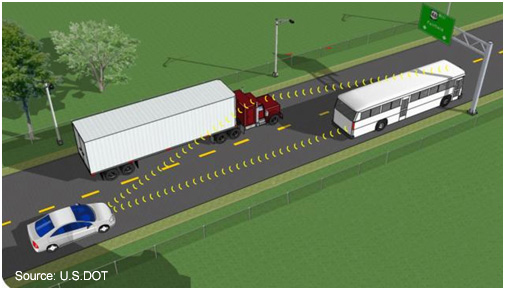The National Highway Traffic Safety Administration (NHTSA) recently published a proposed rule to require all new vehicles to have vehicle-to-vehicle (V2V) communication capabilities. It’s not an official requirement yet, but if it goes into effect in 2019 — a likely timeline for rules like this — manufacturers would be able to phase the technology into their fleets over a few years, with all new vehicles being required to talk to each other by 2023.
The rule not only requires the tech to be on board; it also standardizes the messages that vehicles will share. And because you know you love it, there are plenty of acronyms to be found in the rule. Each car on the road would have a dedicated short-range communications (DSRC) unit that sends out and receives basic safety messages (BSMs).
BSMs are really basic and include data like speed, brake status, and heading — nothing private. The proposal specifically says “NHTSA purposely does not require some elements to alleviate potential privacy concerns.” The goal here is just to make sure all vehicles are speaking the same language in short messages.
The rule also sneaks in a requirement that all vehicles be able to receive over-the-air security and software updates, with “consumer consent … where appropriate.” NHTSA would also like to see firewalls built into vehicles between the V2V modules and the rest of the vehicle’s connected modules to keep ne’er-do-wells from accessing other systems.
That’s not to say V2V will work alone. The rule is quite clear in saying that vehicles should use the information received to engage other on-board sensor and safety systems, like automatic emergency braking. NHTSA also calls out the benefits of vehicles communicating in a swarm and helping each other to see beyond the limits of their own sensors and DSRC messages.
Why bother making an official rule when it seems like the technology is advancing in this direction already? Because the government doesn’t think V2V technology is moving fast enough. “Without government action,” the proposed rule says, “these challenges could prevent this promising safety technology from achieving sufficiently widespread use throughout the vehicle fleet to achieve these benefits.”
NHTSA also notes that without requiring this potentially life-saving technology, buyers might not choose to buy it. If you the consumer only see safety benefits from V2V when other cars have it, but not enough other people are choosing to buy it, then you might not bother to buy it either. So NHTSA is just going to make all of us safer, like it or not.
If you have V2V expertise and strong opinions on the topic, you can comment on the proposed rule by April 12, 2017.
